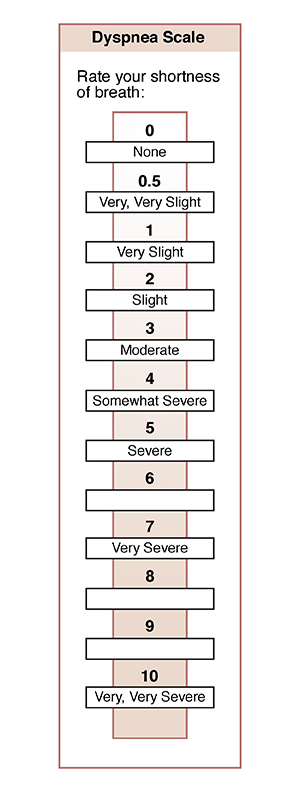Dyspnea is shortness of breath, or breathing discomfort. It's a common symptom that affects many people with lung disease. The Dyspnea Scale measures this shortness of breath. While you exercise, think about how short of breath you feel. Be aware of how hard you are working to breathe. Then pick the number and words on the scale that best shows how you feel at that time. If your shortness of breath is very slight, you’re at level 1. If you feel severely short of breath, you’re at level 5. If you can’t breathe at all, you’re at level 10. Use this scale to help pace your workout. Try to keep your effort level around 3 to 5 on the scale, unless you are advised otherwise.
Signs of overexertion
If you have any of the signs below during exercise, stop. If you’re at the pulmonary rehab facility, tell a team member how you’re feeling. If you’re exercising on your own, based on your symptoms, call your pulmonary rehab team or your healthcare provider. Call 911 if you need emergency care. Watch for these signs:
-
Chest pain or discomfort (burning, tightness, heaviness, or pressure)
-
Pain in your shoulders, arm, neck, jaw, or back that is typical for you
-
A slightly fast or skipping heartbeat
-
Feeling a little lightheaded, dizzy, or nauseated
-
Feeling much more tired than normal
-
Abnormal joint pain
Call 911
Call 911 or get care right away at the nearest emergency department if any of these occur:
-
Shortness of breath that is abnormal, severe, or quickly getting worse
-
Not able to talk
-
Unusual or severe chest pain or discomfort (burning, tightness, heaviness, or pressure)
-
Unusual or severe pain in your shoulders, arm, neck, jaw, or back
-
Feeling very lightheaded or dizzy
-
A very fast or skipping heartbeat
Checking your heart rate
You may be told to check your heart rate during exercise. Press 2 fingers (not your thumb) on the inside of your wrist. Count the number of beats you feel for
My target heart rate: ___________________


